KidZone Mythology:
The Celtic Pantheon
Venture into the misty highlands and emerald forests of the ancient Celtic lands, where a rich tapestry of myths and legends whispers through the leaves and dances on the wind. Here, in a world where the veil between the earthly and the mystical is as thin as a morning fog, the Celtic pantheon reigns, a diverse assembly of gods and goddesses as enigmatic and spirited as the people who revered them.

The Celts, with their profound connection to the natural world, envisioned deities that embodied the forces of nature and the human experience. These gods and goddesses weren't distant figures reigning from lofty thrones; they were integral to the daily life of the Celts, woven into the very fabric of their existence. From the rolling thunder and the nurturing rains to the cycles of growth, death, and rebirth observed in the land, every element held divine significance, and there was a deity to represent every facet of life and the natural world.
These gods and goddesses were celebrated in vibrant stories that captured the imagination, passed down through generations in an oral tradition that kept the divine alive in the hearts of the people. Sacred groves, natural springs, and stone circles served as places of worship, where rituals and ceremonies connected the Celts to the divine forces that shaped their world.
In this realm, where the mystical and the mundane intertwine, the Celtic pantheon continues to enchant and inspire, a testament to the enduring power of myth and the timeless reverence for the natural world and its many mysteries
-
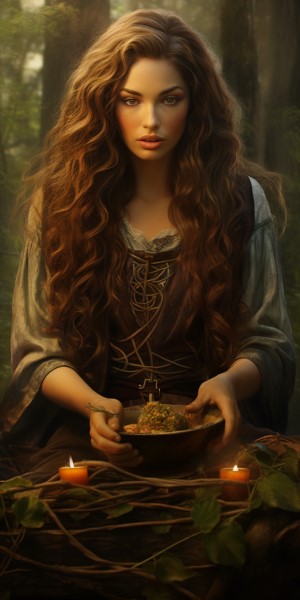 Brigid:
Brigid:In the lush lands of ancient Celtic realms, Brigid, the beacon of spring, brought warmth and light back to the world with her radiant presence. She healed the earth and its inhabitants with her gentle touch, igniting the fires of inspiration and craftsmanship among the people.
-
Appearance: Goddess often depicted as a woman of great beauty, with flowing hair, often holding a flame or surrounded by symbols of domesticity and craftsmanship, such as a forge or healing herbs.
-
Attributes: Brigid is celebrated for her protection, healing, and the fertility of the land that she brings with the coming of spring. She is also the patroness of poets, smiths, and healers, reflecting her diverse talents and benevolence.
-
Symbolism: Her association with fire symbolizes the light of knowledge and the warmth of spring, signifying renewal, healing, and the return of life after winter's dormancy. Brigid's presence marks the beginning of the fertile season, embodying hope and new beginnings.
- more About the Celtic goddess, Brigid
- Brigid coloring pages
- The Tale of Brigid, Goddess of Spring
-
-
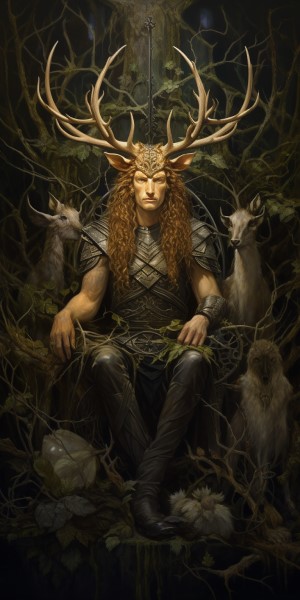 Cernunnos:
Cernunnos:In the heart of the ancient Celtic forests, Cernunnos, the Horned God, roamed the green expanse, a guardian of all creatures and the cycle of life. His silent footsteps whispered through the leaves, a melody of nature's untamed spirit.
-
Appearance: Depicted as a man with the antlers of a stag, often seated in a meditative pose with animals around him, symbolizing his deep connection with the wild and the natural world.
-
Attributes: Cernunnos is revered as the lord of animals, fertility, and wealth, embodying the wild and unpredictable essence of nature. He is often shown with a torque (a symbol of nobility) and a bag of riches, indicating his role in prosperity and abundance.
-
Symbolism: The antlers signify regeneration and growth, as they are shed and regrown annually, mirroring the cycle of death and rebirth in nature. Cernunnos's dominion over animals and the forest represents the interconnectedness of all life and the importance of harmony with the natural world.
- more About the Celtic god, Cernunnos
- Cernunnos coloring pages
-
-
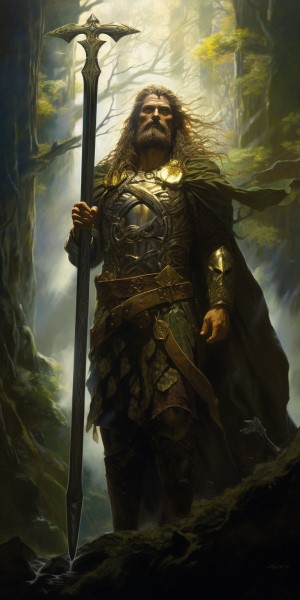 Lugh:
Lugh:Amidst the vibrant tales of the Celts, Lugh, master of crafts and heroic deeds, shone brightly as a figure of versatility and brilliance. His skills were unmatched, earning him the title of 'Samildánach' or 'equally skilled in many arts.'
-
Appearance: Lugh is often portrayed as a youthful warrior or king, radiating charisma and intelligence. He may be shown with a spear or a sling, his favored weapons, and sometimes holding tools representing the various skills he mastered.
-
Attributes: Known for his prowess in battle, artistry, and magic, Lugh's legend encompasses his role as a protector of the people, a champion of justice, and a patron of craftspeople.
-
Symbolism: Lugh's array of skills and his connection to the sun symbolize the light of knowledge, mastery, and the importance of versatility. He embodies the idea that strength lies not only in physical power but also in wisdom, creativity, and adaptability.
- more About the Celtic god, Lugh
-
-
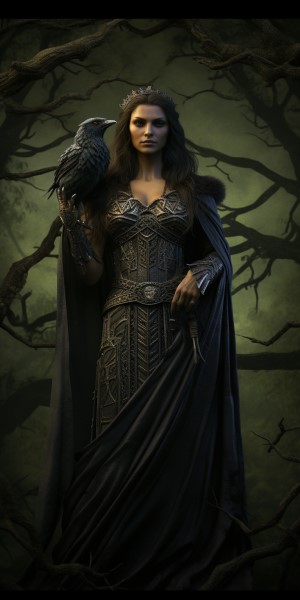 Morrigan:
Morrigan:In the mystical lands of the Celts, Morrigan, the phantom queen, wove the fate of warriors, her shadowy presence a harbinger of victory and doom. Her whispers rode the winds of battle, stirring the hearts of those who dared to face their destiny.
-
Appearance: Morrigan is often depicted as a striking figure cloaked in mystery, with dark hair and attire symbolizing her connection to death and the afterlife. She may appear as a maiden, mother, or crone, reflecting her shape-shifting nature, or as a raven or crow, birds associated with war and death.
-
Attributes: Known as a goddess of war, fate, and sovereignty, Morrigan's presence was believed to turn the tide of battles. She is also associated with prophecy, magic, and the protection of the land and its people.
-
Symbolism: Her ability to transform into a raven symbolizes her role as a guide for souls to the afterlife, while her association with war reflects the inevitable cycles of life, death, and rebirth. Morrigan's complex nature embodies the multifaceted aspects of existence and the sovereignty of the land.
- more About the Celtic goddess, Morrigan
-
-
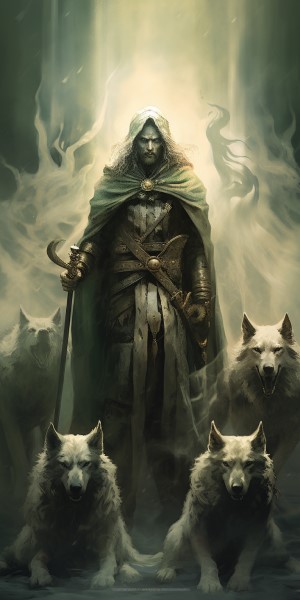 Arawn:
Arawn:In the shadowy realms of the Otherworld, Arawn, ruler of Annwn, presided over the souls of the departed, his kingdom a place of rest and renewal for those journeying beyond the mortal coil.
-
Appearance: Arawn is often portrayed as a king or a hunter, shrouded in the mists of the Otherworld. He may be accompanied by a pack of white, red-eared hounds, creatures of the Otherworld that could traverse between the worlds of the living and the dead.
-
Attributes: As the lord of the Otherworld, Arawn's dominion over life, death, and rebirth made him a figure of awe and reverence. He is associated with hunting, the cycle of life, and the deep, transformative mysteries of death.
-
Symbolism: The white hounds with red ears symbolize the Otherworldly nature of Arawn's realm and his power over life and death. His role as a guide for the souls of the deceased represents the journey of transformation and the continuation of life beyond death.
-
-
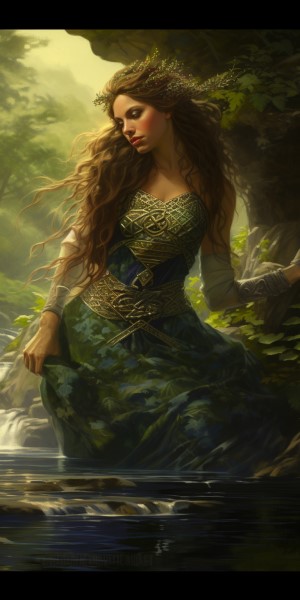 Danu:
Danu:Amidst the rolling hills and flowing rivers, Danu, the mother of the gods, nurtured the land and its inhabitants with her life-giving waters, her essence the wellspring of fertility, abundance, and wisdom.
-
Appearance: Danu is often envisioned as a benevolent, maternal figure, embodying the grace and fertility of the earth. She may be depicted with flowing garments and hair, surrounded by waters and greenery, symbolizing her connection to the earth and its waters.
-
Attributes: Revered as the mother of the Tuatha Dé Danann, the tribe of the gods, Danu's influence permeates the land, her blessings ensuring the prosperity and well-being of all her children.
-
Symbolism: Danu's association with water symbolizes life, purity, and renewal, reflecting her role as the source of life and the nurturing spirit of the earth. Her presence reminds us of the interconnectedness of all living things and the sustaining power of the natural world.
- more About the Celtic goddess, Danu
-
-
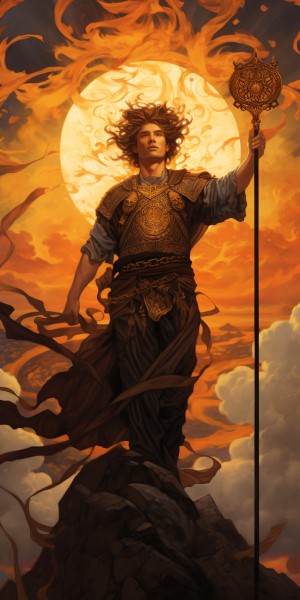 Belenus:
Belenus:With the dawn, Belenus, the shining one, brought the warmth of the sun to the ancient Celtic lands, his golden light chasing away the shadows of night and heralding the promise of a new day.
-
Appearance: Belenus is depicted as a youthful and radiant deity, often associated with the sun and fire. He may be shown driving a chariot across the sky or holding symbols of the sun, emphasizing his connection to light and warmth.
-
Attributes: As a sun god, Belenus's domain included healing, purification, and growth. His benevolent rays were believed to possess healing properties and the power to ensure the fertility of the land and the well-being of its people.
-
Symbolism: Belenus's association with the sun symbolizes life, vitality, and enlightenment. His presence represents the cyclical nature of life, the importance of light in overcoming darkness, and the renewal that comes with each sunrise.
-
-
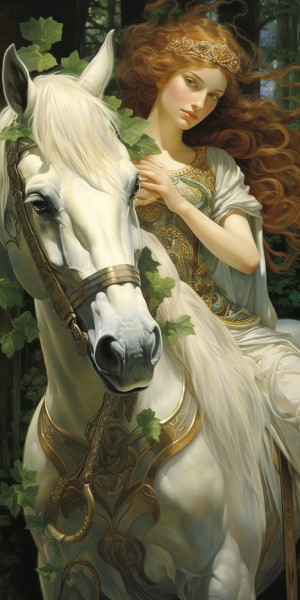 Epona:
Epona:In the green pastures and wild landscapes, Epona, the horse goddess, galloped freely, her spirit intertwined with the horses she protected, embodying the untamed beauty and strength of nature.
-
Appearance: Epona is often depicted in close companionship with horses, sometimes riding them or surrounded by them, highlighting her role as their protector. She may also be shown with cornucopias or baskets of fruit, symbolizing abundance and fertility.
-
Attributes: Revered by horsemen and travelers, Epona's protection was sought for journeys and for the well-being of horses. Her connection to fertility and the earth also made her a goddess of prosperity and abundance.
-
Symbolism: The horse represents freedom, power, and travel, reflecting Epona's domain over movement and transformation. Her association with fertility and abundance underscores the interconnectedness of life, the journey, and the nurturing aspects of the natural world.
- more About the Celtic God, Epona
- Epona coloring pages
-